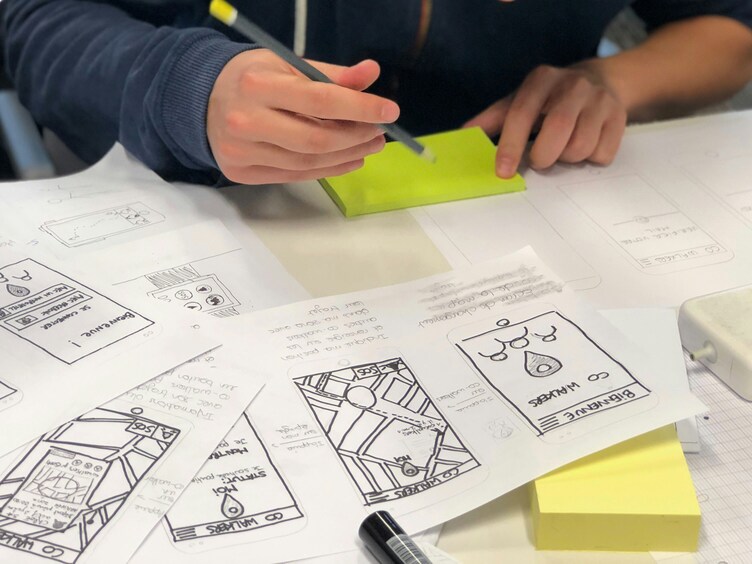
By Manick Mallick | Edited By Hazbyte | Published on 20th Feb 2024
In the realm of user experience (UX) design, success hinges on more than just aesthetics and functionality. It’s about understanding the intricate workings of the human mind and behavior. Every click, swipe, and interaction is influenced by psychological phenomena that shape user perceptions and actions. In this blog, we embark on a journey to unravel the psychology behind nine key UX design principles. By delving into these principles, we uncover the secrets to crafting intuitive, engaging, and user-centric experiences.
Table of Contents
- Principle of Least Effort:
- Principle of Perpetual Habit:
- Principle of Socialization:
- Principle of Emotional Contagion:
- Principle of Identity:
- Principle of Beauty:
- Magical Number Seven, Plus or Minus Two:
- Psychology of Mistakes:
- Focus, Attention, and Concentration:
Unravel the psychology behind nine key UX design principles:-
Principle of Least Effort:
The Principle of Least Effort dictates that people seek the path of least resistance when completing tasks. Whether it’s navigating a website or using an app, users prefer simplicity and efficiency. As UX designers, our goal is to minimize cognitive load and streamline user interactions. By employing techniques such as intuitive navigation, clear instructions, and interactive demos, we empower users to accomplish their goals with minimal effort.
Principle of Perpetual Habit:
Humans are creatures of habit, and this holds true in the digital realm as well. The Principle of Perpetual Habit underscores the importance of familiarity and consistency in UX design. Users rely on established patterns and conventions when navigating websites and apps. By adhering to familiar layouts, standardized icons, and intuitive navigation structures, we create seamless user experiences that feel second nature.
Principle of Socialization:
In an increasingly connected world, the Principle of Socialization plays a pivotal role in UX design. People crave social interaction and validation, even in digital spaces. Integrating social sharing buttons, user testimonials, and community features fosters a sense of belonging and engagement. By tapping into users’ innate desire for social connection, we create experiences that resonate on a deeper level.
Principle of Emotional Contagion:
Emotions are contagious, and this phenomenon holds profound implications for UX design. The Principle of Emotional Contagion highlights the power of emotion in shaping user behavior. Through compelling storytelling, emotive visuals, and empathetic design, we evoke specific emotions that resonate with users on a visceral level. By harnessing the power of emotional contagion, we forge deeper connections and drive user engagement.
Principle of Identity:
At the core of human behavior lies the need for identity and belonging. The Principle of Identity emphasizes the role of brand identity and personalization in UX design. By creating unique brand experiences and offering personalized interactions, we cultivate a sense of belonging and loyalty among users. Whether through tailored recommendations or customizable features, we empower users to express their identity and forge meaningful connections with our products.
Principle of Beauty:
Beauty is not just skin deep—it’s a fundamental aspect of human perception. The Principle of Beauty underscores the importance of aesthetics in UX design. By leveraging visual elements such as color theory, typography, and imagery, we create visually stunning experiences that captivate users’ attention. Beauty goes beyond aesthetics; it encompasses usability, functionality, and emotional resonance. By marrying form and function, we create experiences that delight the senses and elevate user satisfaction.
Magical Number Seven, Plus or Minus Two:
Human memory is finite, and this principle holds profound implications for UX design. The Magical Number Seven, Plus or Minus Two, posits that people can only hold a limited amount of information in their short-term memory. As UX designers, we must respect this cognitive constraint and design experiences that accommodate users’ mental bandwidth. By presenting information in digestible chunks, organizing content hierarchically, and leveraging progressive disclosure, we optimize user comprehension and retention.
Psychology of Mistakes:
Mistakes are inevitable, but they need not be detrimental. The Psychology of Mistakes explores how UX designers can mitigate user errors and frustrations. By anticipating common pitfalls, providing clear instructions, and offering error feedback, we guide users through seamless experiences. Action confirmation, undo functionality, and intuitive error messages empower users to navigate complex tasks with confidence and ease.
Focus, Attention, and Concentration:
In an age of information overload, maintaining user focus is paramount. The Principle of Focus, Attention, and Concentration addresses the challenges of capturing and retaining users’ attention. By minimizing distractions, creating clear visual hierarchies, and employing progressive engagement techniques, we keep users engaged and immersed in our experiences. Whether through subtle animations, interactive elements, or strategic content placement, we guide users’ attention and enhance their overall experience.
Conclusion
Understanding user behavior is the cornerstone of effective UX design. By delving into the psychology behind nine key principles, we unlock the secrets to creating engaging, intuitive, and user-centric experiences. From minimizing cognitive load to fostering social connection, from evoking emotions to accommodating memory constraints, each principle offers valuable insights into shaping the future of UX design. By harnessing the power of psychology, we empower users to connect, engage, and thrive in the digital landscape.

Opting for Hazbyte for authentic AI tools information and reviews is a wise choice for several compelling reasons. Hazbyte stands out as a reliable source, committed to providing unbiased and accurate insights into the ever-expanding landscape of AI tools. The platform employs thorough research methodologies, ensuring that the information presented is up-to-date and reflective of the latest advancements in the field. The reviews on Hazbyte are characterized by their depth and comprehensiveness, offering valuable perspectives on the functionality, usability, and real-world applications of AI tools. The platform’s commitment to transparency and objectivity instills confidence in readers, making it a trustworthy guide for individuals seeking genuine evaluations before making informed decisions. Hazbyte’s dedication to delivering credible and unbiased content establishes it as a go-to resource for those navigating the complex and rapidly evolving realm of AI tools.






